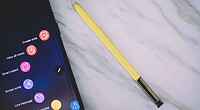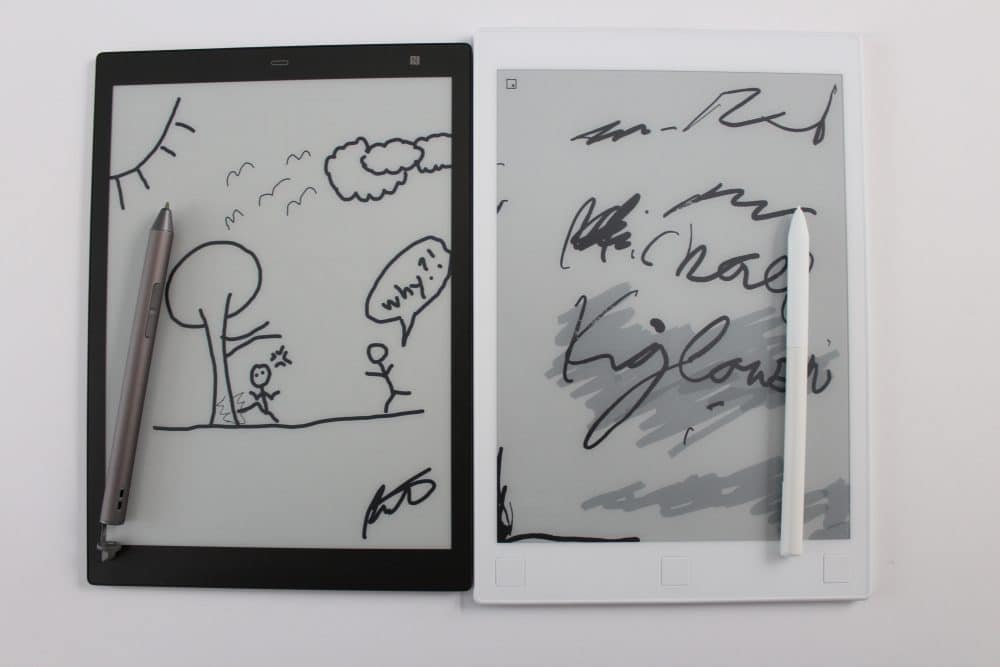The Sony Digital Paper DPT-CP1 and the Remarkable both have 10.3 inch screens and these two products are aimed at businesses or prosumers. They are designed to take notes, edit PDF files and be a replacement for paper. The Remarkable stylus has pressure sensitivity, can read EPUB books and can also edit them too. The Sony does a really good job with viewing and editing multiple documents in landscape mode.
The Remarkable 10.3 inch-writing tablet is appealing for consumers who want an extensive note taking experience and want to read e-books. This is the first product made by Remarkable and it is a very compelling first offering. The screen has a capacitive touchscreen and you can interact with most elements with your finger or the accompanied stylus. The note taking experience has palm rejection technology, which means you can easily rest your palm on it. The screen is completely flush with the bezel and the resolution is 1872×1404 with 226 PPI.
Underneath the hood is a 1GHZ Arm A8 CPU processor and 512MB of RAM. You have 8GB of internal storage and there is no SD card. The Remarkable has Wi-Fi that is primarily uses to fetch firmware updates and to synchronize your notes on a local network.
The Remarkable stylus has over 2,048 levels of pressure sensitivity, which allows you to draw thicker and thinner lines by adjusting the pressure on the marker. The different brushes have different pressure sensitivity , which creates a more organic feeling. The Sony DPT does not have pressure sensitivity and you have to select the different pen/pencil sizes. The Sony stylus also has interchangeable nibs for the stylus, one is plastic and the other is graphite to emulate a pencil.
The brand new Sony Digital Paper DPT-CP1 is the companies first 10.3 inch model and is running the exact same operating system and firmware, so there are no cool little features that make it distinctive. Sony primarily developed this model because they wanted a low cost alternative for businesses, companies or government agencies to go paper free.
The Sony DPT-Cp1 features an E-Ink Carta display with a resolution of 1872×1404 with 227 PPI. It has a capacitive layer for touchscreen interactions and also one for the stylus to take notes and write on PDF files.
The screen itself doesn’t have a back or front light, and has the slightly gray background of lower-cost Kindles. The PPI is not as sharp as the standard 300-ppi display on the latest ebook readers, and you can tell that when trying to read very small text or look at maps. The 16 levels of grayscale are standard for E Ink and are fine for graphs, charts, documents or maps.
Underneath the hood is a Marvell IAP 140 64-bit Quad-core IoT Applications Processor,1GB of RAM, 16GB of internal storage, WIFI and Bluetooth 4.2. The dimensions are 174.2 × 243.5 × 5.9 mm and it weighs approximately 240 g.
Both of these devices heavily lean on proprietary software to transfer PDF files and ebooks. There are also mobile apps that allow you to transfer documents to the readers, but cannot transfer files to the e-readers. Remarkable lets you do live drawing, whatever you do the screen will show up on the PC. Sony has a projector function for the same thing.
This video comparison gives you a sense of the hardware design, menu system and what the note taking experience is like. If you are on the fence on what one of these models is applicable for your specific use case scenarios, check it out.
Michael Kozlowski is the editor-in-chief at Good e-Reader and has written about audiobooks and e-readers for the past fifteen years. Newspapers and websites such as the CBC, CNET, Engadget, Huffington Post and the New York Times have picked up his articles. He Lives in Vancouver, British Columbia, Canada.

